A limited sampling schedule to estimate individual pharmacokinetic parameters of fludarabine in hematopoietic cell transplant patients
- PMID: 19671874
- PMCID: PMC2763506
- DOI: 10.1158/1078-0432.CCR-09-0427
A limited sampling schedule to estimate individual pharmacokinetic parameters of fludarabine in hematopoietic cell transplant patients
Abstract
Purpose: Fludarabine monophosphate (fludarabine) is frequently administered to patients receiving a reduced-intensity conditioning regimen for allogeneic hematopoietic cell transplant (HCT) in an ambulatory care setting. These patients experience significant interpatient variability in clinical outcomes, potentially due to pharmacokinetic variability in 2-fluoroadenine (F-ara-A) plasma concentrations. To test such hypotheses, patient compliance with the blood sampling should be optimized by the development of a minimally intrusive limited sampling schedule (LSS) to characterize F-ara-A pharmacokinetics. To this end, we sought to create the first F-ara-A population pharmacokinetic model and subsequently a LSS.
Experimental design: A retrospective evaluation of F-ara-A pharmacokinetics was conducted after one or more doses of daily i.v. fludarabine in 42 adult HCT recipients. NONMEM software was used to estimate the population pharmacokinetic parameters and compute the area under the concentration-time curve.
Results: A two-compartment model best fits the data. A LSS was constructed using a simulation approach, seeking to minimize the scaled mean squared error for the area under the concentration-time curve for each simulated individual. The LSS times chosen were 0.583, 1.5, 6.5, and 24 hours after the start of the 30-minute fludarabine infusion.
Discussion: The pharmacokinetics of F-ara-A in an individual HCT patient can be accurately estimated by obtaining four blood samples (using the LSS) and maximum a posteriori Bayesian estimation.
Conclusion: These are essential tools for prospective pharmacodynamic studies seeking to determine if clinical outcomes are related to F-ara-A pharmacokinetics in patients receiving i.v. fludarabine in the ambulatory clinic.
Figures


References
-
- Copelan EA. Hematopoietic stem-cell transplantation. N Engl J Med. 2006;354:1813–26. - PubMed
-
- Deeg HJ, Maris MB, Scott BL, Warren EH. Optimization of allogeneic transplant conditioning: not the time for dogma. Leukemia. 2006;20:1701–5. - PubMed
-
- Baron F, Storb R, Little MT. Hematopoietic cell transplantation: five decades of progress. Arch Med Res. 2003;34:528–44. - PubMed
-
- Aoudjhane M, Labopin M, Gorin NC, et al. Comparative outcome of reduced intensity and myeloablative conditioning regimen in HLA identical sibling allogeneic haematopoietic stem cell transplantation for patients older than 50 years of age with acute myeloblastic leukaemia: a retrospective survey from the Acute Leukemia Working Party (ALWP) of the European group for Blood and Marrow Transplantation (EBMT) Leukemia. 2005;19:2304–12. - PubMed
-
- Maris MB, Niederwieser D, Sandmaier BM, et al. HLA-matched unrelated donor hematopoietic cell transplantation after nonmyeloablative conditioning for patients with hematologic malignancies. Blood. 2003;102:2021–30. - PubMed
Publication types
MeSH terms
Substances
Grants and funding
LinkOut - more resources
Full Text Sources

